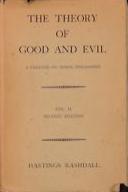Philosophy:The Theory of Good and Evil
 | |
| Author | Hastings Rashdall |
|---|---|
| Country | United Kingdom |
| Language | English |
| Subject | Ethics |
| Publisher | The Clarendon Press |
Publication date | 1907 |
| Media type | Print (Hardcover and Paperback) |
| Pages | 312 (vol. 1, Elibron edition) 464 (vol. 2, Elibron edition) |
| ISBN | ISBN:978-1112155512 (vol. 1) 978-1112155505 (vol. 2) |
The Theory of Good and Evil is a 1907 book about ethics by the English philosopher Hastings Rashdall. The book, which has been compared to the philosopher G. E. Moore's Principia Ethica (1903), is considered Rashdall's most important philosophical work. Some commentators have suggested that, compared to Principia Ethica, the work has been unfairly neglected.
Summary
The Theory of Good and Evil is dedicated to the philosophers Thomas Hill Green and Henry Sidgwick. In the work, Rashdall discusses ethics. Subjects addressed include utilitarianism, the work of the philosopher G. E. Moore, including Principia Ethica, the work of the philosopher F. H. Bradley, and Christian theology.[1] In his second volume, he deals with potential objections to his views.[2]
Publication history
The Theory of Good and Evil was first published by the Clarendon Press in 1907. In 2004, it was republished by Elibron Classics.[3]
Reception
Academic journals
The Theory of Good and Evil was discussed by Daniel Shannon in Saint Anselm Journal. Shannon described the book as Rashdall's best known work, but criticized Rashdall's evaluation of Christian theology.[4]
Evaluations in books
The philosopher Richard Wollheim described The Theory of Good and Evil as "a compendious work marred by priggishness" in F. H. Bradley (1969).[5] The philosopher John Rawls compared Rashdall's ethical views to those of Moore, writing in A Theory of Justice (1971) that the position that the capacity for a higher life may be grounds for treating men unequally is implicit in Principia Ethica.[6] R. S. Downie considered Rashdall's dedication of The Theory of Good and Evil to Green and Sidgwick appropriate, noting in The Oxford Companion to Philosophy (2005) that Rashdall was indebted to both philosophers. He suggested that Rashdall had been "unfairly eclipsed as a moral philosopher" by Moore.[7]
The philosopher Thomas Hurka described The Theory of Good and Evil as Rashdall's principal philosophical work in The Cambridge Dictionary of Philosophy (2015). Hurka suggested that because the work was published four years after Principia Ethica, it was unfairly neglected, despite presenting a more extensive treatment of some subjects. He considered Rashdall's most important contribution to be "to show how virtue can be valued intrinsically within a consequentialist framework".[8]
See also
References
- ↑ Rashdall 2004, pp. v–vii.
- ↑ Rashdall 2004, pp. iii, 1, 83, 287, 311.
- ↑ Rashdall 2004, p. ii.
- ↑ Shannon 2009, pp. 1–19.
- ↑ Wollheim 1969, p. 271.
- ↑ Rawls 1999, p. 287.
- ↑ Downie 2005, p. 782.
- ↑ Hurka 2017, pp. 901–902.
Bibliography
- Books
- Downie, R. S.; Honderich, Ted, Editor (2005). The Oxford Companion to Philosophy, Second Edition. Oxford: Oxford University Press. ISBN 0-19-926479-1.
- Hurka, Thomas; Audi, Robert, Editor (2017). The Cambridge Dictionary of Philosophy, Second Edition. Cambridge: Cambridge University Press. ISBN 978-1-107-64379-6.
- Rashdall, Hastings (2004). The Theory of Good and Evil, Volume I. Oxford: Elibron Classics. ISBN 1-4212-7171-0.
- Rashdall, Hastings (2004). The Theory of Good and Evil, Volume II. Oxford: Elibron Classics. ISBN 1-4212-6909-0.
- Rawls, John (1999). A Theory of Justice. Cambridge: Harvard University Press. ISBN 0-674-00078-1.
- Wollheim, Richard (1969). F. H. Bradley. Harmondsworth: Penguin Books.
- Journals

